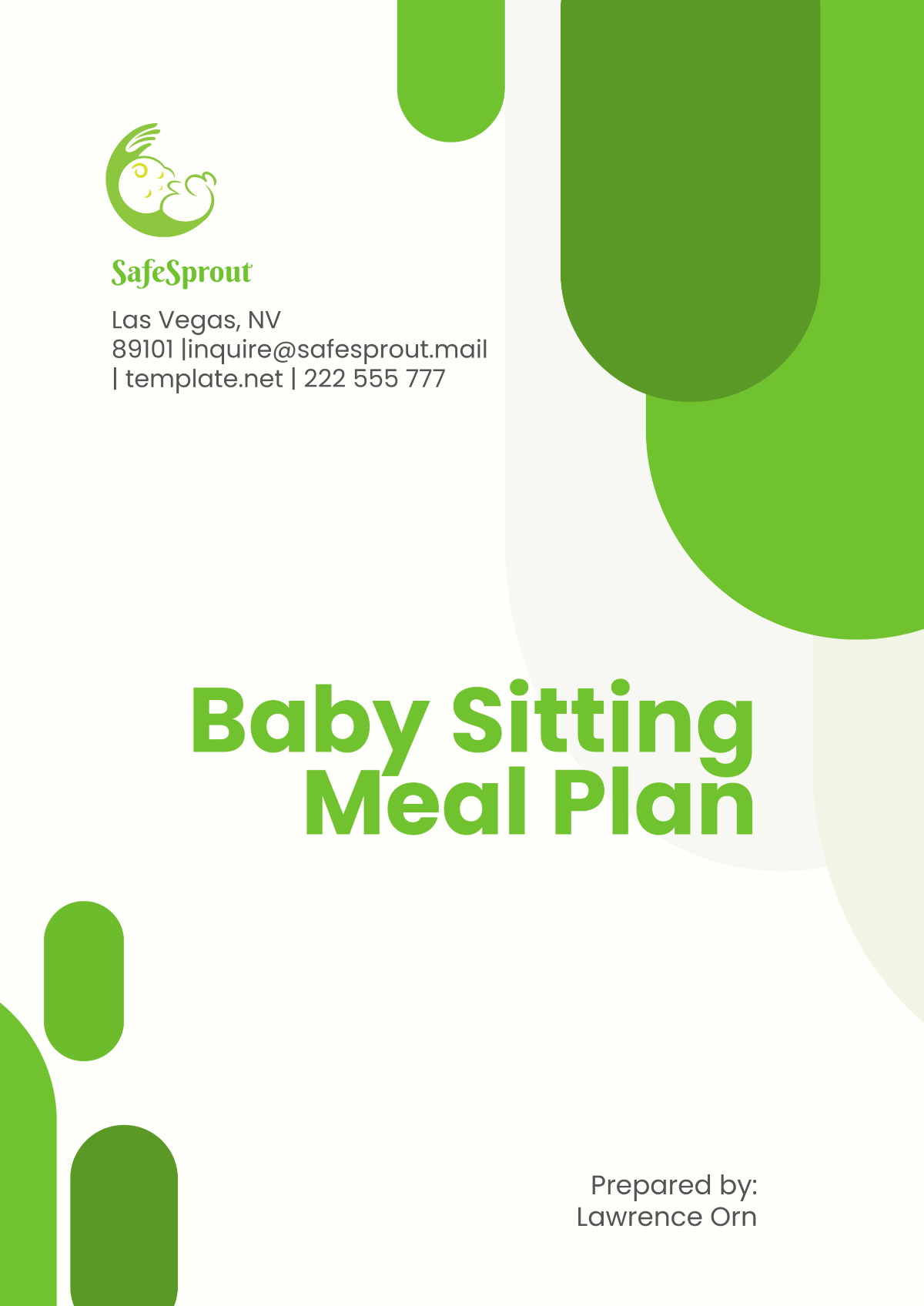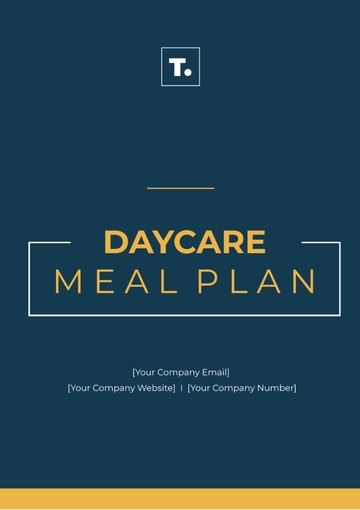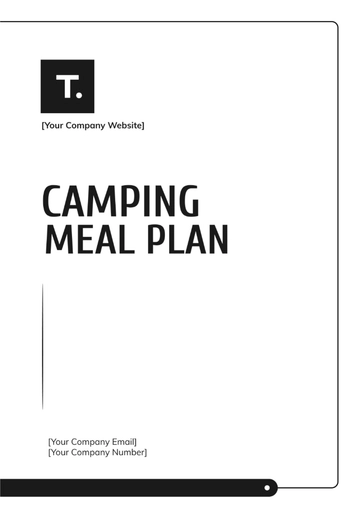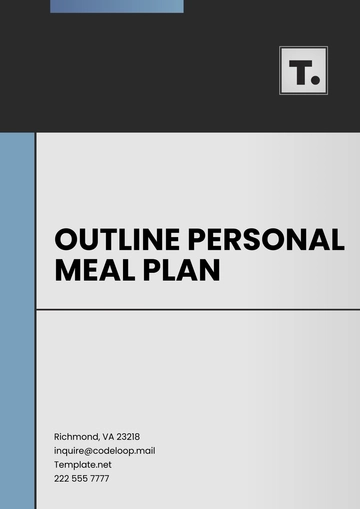Free Baby Sitting Meal Plan

I. Introduction
A. Purpose of the Meal Plan
[Your Company Name]'s Baby Sitting Meal Plan is designed to ensure that the child’s nutritional needs are met while in the care of a babysitter. It provides a variety of balanced, age-appropriate meals that promote healthy growth and development. This plan also offers easy-to-follow guidelines to help the babysitter prepare nutritious meals without stress.
B. Age of the Child
The meals in this plan are specifically tailored for children aged 12-24 months, which is a critical time for introducing a variety of textures and foods. At this stage, toddlers are developing their eating habits and preferences, so meals should be appealing and fun. Care must also be taken to ensure that the meals are cut into appropriate sizes to prevent choking hazards.
C. Parental Preferences
Parents may have specific dietary preferences, food allergies, or cultural food practices that should be incorporated into the meal plan. The babysitter should be informed of any restrictions, such as gluten-free or dairy-free options. It is important that the meals align with the child’s likes and dislikes to make mealtime enjoyable.
II. Nutritional Guidelines
A. Key Nutrients to Include
The child’s diet should include a balance of protein, healthy fats, and essential vitamins. Protein-rich foods like chicken, fish, and beans support muscle development, while healthy fats from sources like avocado promote brain health. Calcium-rich foods like dairy or fortified plant-based milks are vital for developing strong bones and teeth.
B. Balanced Macronutrients
Each meal should contain a balance of complex carbohydrates, lean proteins, and healthy fats to provide sustained energy. Carbs such as whole grains, sweet potatoes, and fruits give the child the energy needed for daily activities. Including a variety of food groups at each meal helps create a well-rounded diet.
C. Avoiding Common Allergens
It’s essential to be mindful of food allergies, particularly common ones like dairy, eggs, and peanuts. If the child has food sensitivities, alternative foods like almond butter or soy milk should be used. Always check labels carefully and prepare food at home to avoid cross-contamination with allergens.
III. Meal Timing & Structure
A. Meal Frequency
The child should be fed three meals and two snacks throughout the day to maintain energy levels. It is important that snacks provided to children are nutritious, as they contribute to their overall health and well-being. Ideally, these snacks should be offered at times that fall between regular meals to help prevent any fussy behavior that might arise from feelings of hunger. The timing of snack offerings should be flexible enough to accommodate the child's natural eating habits and preferences, while also maintaining enough regularity to establish a comforting and predictable routine.
B. Meal Timing Considerations
Breakfast should be served within an hour of waking up to kick-start metabolism and energy levels. Lunch ought to be provided approximately four to five hours after breakfast to prevent extended periods between meals. Ideally, dinner should be served approximately one hour before bedtime, thereby giving the child adequate time to digest the meal prior to going to sleep.
C. Snack Guidelines
Healthy snacks like fruit slices, cheese, or whole-grain crackers are ideal to keep the child satisfied between meals. The preparation of these items should be straightforward, ensuring that they do not include sugary or highly processed foods. Additionally, the snacks should be convenient for the child to consume on their own without needing help, which will foster and support their independence.
IV. Age-Appropriate Meal Components
A. Infants (6-12 Months)
For babies in this age range, meals should be soft and pureed, such as mashed sweet potatoes, apple puree, and rice cereal. Iron-fortified cereals are important for boosting iron levels, and should be mixed with breast milk or formula for a smooth consistency. Pureed vegetables and fruits like carrots, peas, and pears should be offered for variety and nutrition.
B. Toddlers (12-24 Months)
At this stage, toddlers can begin eating small, soft finger foods like scrambled eggs, small pieces of chicken, and sliced fruit. Meals ought to remain easy to chew, ensuring that any hard or tough textures are avoided. Incorporating a variety of textures, such as soft vegetables, pasta, and mild cheese, will encourage the child to explore new foods.
C. Preschoolers (2-3 Years)
Preschoolers enjoy more independence, so meals can include foods they can feed themselves, like small sandwiches, veggie sticks with hummus, and mild pasta dishes. Foods should still be cut into small, manageable pieces to prevent choking. Encourage eating a variety of foods to help establish lifelong healthy eating habits.
V. Hydration
A. Water Intake
Throughout the day, the child should be offered water regularly, especially during and after meals to stay hydrated. Water is the most optimal option for maintaining proper hydration because sugary beverages, such as fruit juice, have the potential to lead to cavities and sudden drops in energy levels due to sugar crashes. It is advisable for the babysitter to provide water at snack times in order to help ensure that hydration levels are consistently maintained.
B. Milk & Alternatives
Whole milk (for children over 1 year) provides essential fats for growth, but plant-based alternatives like oat milk can be used for children with dairy sensitivities. It’s important to offer milk at meals but limit intake to avoid reducing appetite for solid foods. Aim for 16-24 ounces of milk per day to ensure the child’s nutritional needs are met without overfilling them.
C. Juice Guidelines
Juice should be limited to 4-6 ounces per day and should be served in a cup, not a bottle. Children should only be served juice that is composed entirely of fruit, with no added sugars or other ingredients. If needed, this juice should be mixed with water to reduce its concentration. Although fruit juice can contribute certain vitamins to the diet, it is generally recommended that whole fruits be consumed instead, as they typically offer a more comprehensive range of nutritional benefits.
VI. Meal Preparation Tips
A. Batch Cooking and Prepping
Prepare some meals in bulk, such as cooking large batches of pasta or roasting vegetables, to save time during the babysitting period. These meals have the capability to be divided into individual portions and can be placed in either the refrigerator or the freezer. This allows for convenient and straightforward retrieval whenever needed. As a result, it becomes less complicated for the babysitter to provide a healthy and nutritious meal. The babysitter can do so without undergoing the entire process of cooking from the beginning each time a meal needs to be served.
B. Quick Meal Ideas
Quick meals can include things like a scrambled egg with avocado, small pieces of fruit, and soft cheese. The objective of these meals is to provide options that are both nutritious and straightforward to prepare, allowing individuals to serve them in less than ten minutes. The intention is to create dishes that are simple to make, requiring minimal preparation time, while still delivering the essential nutritional benefits.
C. Safe Food Storage
Prepared meals should be stored in airtight containers in the fridge for up to 2 days or in the freezer for longer storage. When you are reheating food, it is important to make sure that it is heated thoroughly in order to prevent any potential foodborne illnesses. Additionally, any leftovers should be consumed within two days to maintain their freshness and ensure they are safe to eat.
VII. Special Considerations
A. Food Allergies
If the child has food allergies, it’s critical to avoid any known allergens and use safe alternatives. Make it a regular practice to thoroughly examine all product labels to ensure there are no potential allergens present, and steer clear of prepackaged or prepared foods that could have undisclosed allergenic ingredients. Additionally, ensure that the babysitter is well-informed by clearly explaining any necessary emergency procedures to follow in the event of an allergic reaction.
B. Choking Hazards
Foods should be cut into small, manageable pieces to prevent choking. It is advisable to steer clear of offering foods such as whole grapes, sizable portions of meat, or popcorn, as these items could present a choking hazard. It is essential to constantly supervise the child during mealtime to ensure they are eating safely.
C. Developmental Considerations
Adjust food textures based on the child’s developmental milestones. For infants and younger toddlers, foods should be pureed or mashed, while older toddlers can handle soft, small finger foods. Encouraging self-feeding with utensils helps the child develop motor skills.
VIII. Meal Ideas by Type
A. Breakfast
Soft scrambled eggs with spinach and cheese
Oatmeal with mashed bananas or applesauce
Whole-grain waffles with peanut butter and sliced strawberries
B. Lunch
Mini sandwiches with turkey or cheese
Soft chicken and vegetable stew with mashed potatoes
Avocado and bean wrap, cut into small pieces
C. Dinner
Grilled chicken with roasted sweet potato and steamed broccoli
Pasta with a mild tomato sauce and grated cheese
Veggie stir-fry with tofu, served with rice
IX. Meal Serving & Feeding Techniques
A. Self-Feeding
Encourage the child to feed themselves using finger foods like sliced fruits, crackers, or soft vegetables. For toddlers who are a bit older, it is beneficial to introduce them to utensils, such as small spoons and forks, so they can practice the skill of feeding themselves. This activity encourages independence and also plays a crucial role in aiding the child in developing their fine motor skills.
B. Portion Sizes
Serve small portions of food and allow the child to ask for more if needed. Serving excessively large portions can result in unnecessary waste and can cause frustration, particularly if the child is unable to consume the entire meal. Offering smaller portions can alleviate feelings of being overwhelmed in children and promote a balanced approach to portion control, ultimately encouraging healthier eating habits.
C. Positive Eating Environment
Meals should be served in a calm and positive environment without distractions like TV. This practice assists the child in concentrating on their meal, thereby promoting mindful eating habits. It is beneficial to provide positive reinforcement, such as offering praise to the child when they try new foods or successfully finish their meal.
X. Final Notes and Communication with Babysitter
A. Meal Preparation Instructions
Provide clear instructions on how to prepare and serve each meal, including reheating instructions if necessary. Ensure the babysitter is aware of any foods that need to be avoided due to allergies or preferences. If any substitutions are needed, make sure the babysitter is comfortable with the changes.
B. Behavioral Cues
Teach the babysitter how to recognize when the child is hungry, full, or not interested in food. Some children may refuse food due to teething or other discomforts, so patience is key. If the child refuses a meal, the babysitter should offer a simple snack or another option later.
C. Communication with Parents
Set up a system for the babysitter to communicate with the parents regarding meal progress or concerns. This could be as simple as texting or noting down any changes in appetite or food preferences. Parents should feel confident that their child is being well-fed and that any concerns will be addressed.
- 100% Customizable, free editor
- Access 1 Million+ Templates, photo’s & graphics
- Download or share as a template
- Click and replace photos, graphics, text, backgrounds
- Resize, crop, AI write & more
- Access advanced editor
Manage your babysitting meal planning with ease using the customizable Baby Sitting Meal Plan Template from Template.net. This editable template allows you to tailor meal plans to fit your child's specific needs and preferences. With the integrated AI Editor Tool, quickly adjust meals, portion sizes, and schedules, ensuring a smooth, nutritious mealtime every time.





























